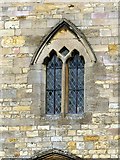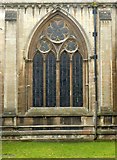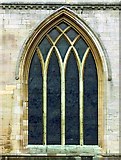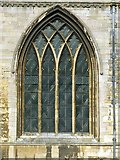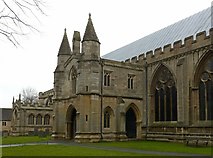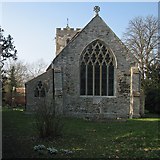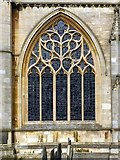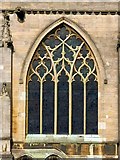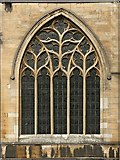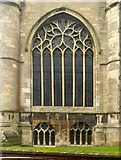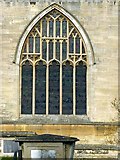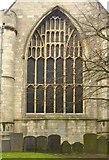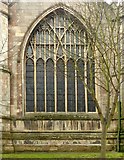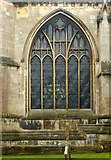The Windows of St Wulfram, Grantham
Contents
- A concise guide to English Gothic window tracery
- Terminology
- The Windows of St Wulfram's Church, Grantham
- Early English Period - late 12th century to late 13th century
- Plate tracery
- Geometric tracery, c.1270-1300
- Intersecting tracery, c.1310
- Decorated Period - c.1310-1350
- Reticulated tracery
- Curvilinear tracery
- Perpendicular period, c.1350 - 1530
- Panel tracery
A concise guide to English Gothic window tracery
Terminology
Tracery is the name given to the main bars separating the elements of large windows, especially those found in churches. Vertical bars are called mullions, and horizontal elements are called transoms. The development of tracery arose from the desire to let more light into churches with larger windows, at a time when glass could not be produced in large sheets.The Windows of St Wulfram's Church, Grantham
Remarkably, the main windows of the parish church of St Wulfram in Grantham form in themselves an encyclopedia of the development of styles from the mid 13th to the mid 15th century in effectively chronological order, so a walk around the church provides a suitable guide in its own right.Before starting the main walk, a visit to the south porch is necessary, to introduce us to the earliest form of tracery.
Early English Period - late 12th century to late 13th century
Plate tracery
The blank area above multiple window openings typical of the Norman period was relieved by piercing openings, often with a decorative outlineFrom here we pass round to the north side of the church to start the circuit proper, which takes place in an anticlockwise direction. There are 6 windows along the wall of the north aisle, 3 either side of the porch, and following the system set out in the church's own guides, they are numbered 1-6 from east to west (left to right). These 6 windows all have the same pattern of tracery.
Geometric tracery, c.1270-1300
This is characterised by the use of regular geometric shapes, particularly circles, as in this instance.Window 7 north aisle, west end
A larger window with more complex tracery
A larger window with more complex tracery
Window 8 is dealt with under window 10
Window 9 is also Geometric, although of a different pattern to Window 7.
Intersecting tracery, c.1310
Here the ribs split at the level of the spring of the arch, and are curved to the same radius as the outer arch, thus intersecting with each other in a regular pattern.Window 8 in the centre of the west front is identical but decorated profusely with ballflower.
Where there are only two lights in the window, the usual name given is Y-tracery

Examples of this at St Wulfram's can be seen in windows of the ringing chamber of the tower.
These are identical, similar to window 10 but now with decorative cusps on the bars, pointing towards the
Decorated Period - c.1310-1350
Window 13 is chronologically out of sequence and we will take the opportunity to cross back to the north porch. This has several windows with examples ofReticulated tracery
The ribs curve in and out of themselves to form a regular honeycomb pattern.The windows are not so clearly visible in that picture, so the following provides a better example
Returning to the south side of the church, we continue with the fully mature style of the Decorated period
Curvilinear tracery
featured in all the windows of the Lady Chapel, built around 1350. The variety of invention makes it worth showing the individual windows separatelyand at the east end of the chapel, the largest and most intricate of the group
These windows show an intricacy of tracery that is probably not exceeded except in some of the largest cathedral windows. Apart from those resulting from symmetry, essentially no two shapes in any window are identical.
With the increasing size and height of windows being created from the second half of the 14th century onwards, such as the great east windows at Gloucester and York, support for large areas of glass became critical and mullions tended to be continued vertically through to the top of the window, creating the
Perpendicular period, c.1350 - 1530
Panel tracery
This was the final phase of the Gothic era, fading out following the Reformation and being supplanted by the renaissance styles of the Tudor period. At St Wulfram's it is represented by the following windows, all very typical of the style.Window 19, the east window of the Corpus Christi Chapel, is the most elaborate of these, combining sections which can be read as single lancets, or overlapping 4-light units, melded into a single 7 light window. The circular and teardrop shaped elements are unusual in windows of this period.
The Corpus Christi Chapel represents the final phase of construction of St Wulfram's Church and brings us to the end of our circuit.
![Creative Commons Licence [Some Rights Reserved]](https://s1.geograph.org.uk/img/somerights20.gif)
